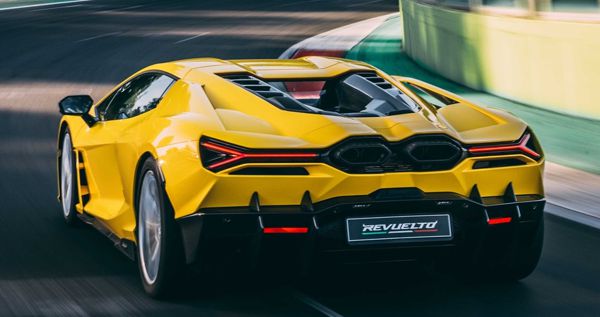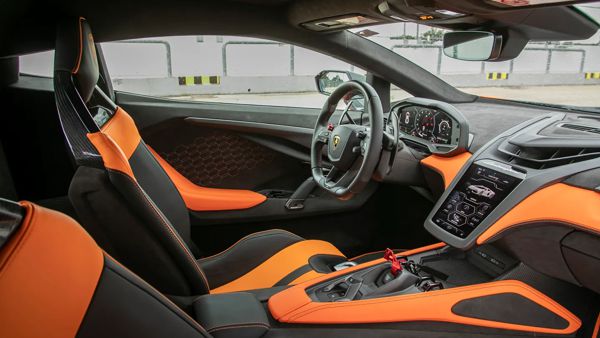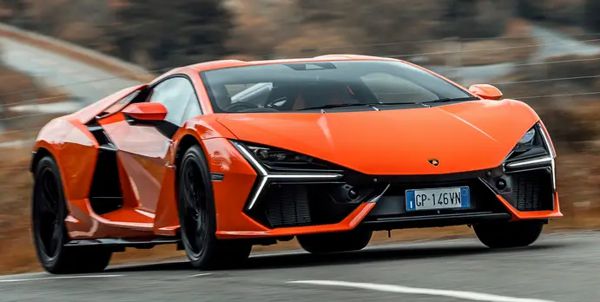 |
|
Thanks
to hybrid power, the Lambo finally enters hypercar territory.
|
|
After almost 12 years,
Lamborghini Aventador is finally replaced with an all-new model,
Revuelto. Sant’Agata’s 6th generation flagship supercar – following
Miura, Countach, Diablo, Murcielago and Aventador – is once again named
after a Spanish fighting bull. Revuelto means “mixed” in English, which
implies the car’s battery electric hybrid powertrain, a first for
Lamborghini (Sian and Countach LPI used supercapacitor instead of
battery).
The new big Lambo gets bigger again. Measuring 4950 mm in length, it is
170 mm longer than the original Aventador. Some 80 mm of which goes to
the wheelbase, which should improve interior space. It is also 34 mm
taller, but body width is unchanged at 2030
mm, which is already marginal to drive on country lanes.
The styling is very aggressive but far from surprising, because it
keeps the wedge proportion that started from Countach, and the detailed
design is consistent with the design theme taken by Lamborghini in the
last decade or so. Sharp and edgy, with liberal use of star and
hexagonal elements for visual impact, while side intakes are
arrow-shape, extending to the floating blades that link between rear
fenders and C-pillars. To give a better view on the V12 engine, the
latter is exposed, not even a glass cover is employed. Moreover, a
stripe of brake light located at the trailing edge of roof panel puts
the V12 under limelight whenever braking, isn't it too showy?
Lamborghini said its active aerodynamics – the rear spoiler is
adjustable – can generate 66 percent more downforce than the last
Aventador Ultimae, thanks to larger diffusers as
well as a channel pressed onto the roof panel that draws airflow
towards
the rear spoiler. Meanwhile, aerodynamic efficiency (i.e. drag divided
by downforce) is slightly less impressive at 61 percent up, implying
its
drag coefficient is slightly higher than the Aventador.
 |
|
1015
horsepower without sacrificing the noise of naturally aspirated V12.
Wise.
|
|
Having slipped behind the
competition in performance chart for so many years, Lamborghini finally
decides to strike back with a big boost of power. However, instead of
taking the turbocharging route as its rivals, it opts
to keep its traditional naturally aspirated V12, which is admittedly
the key reason to buy a Lamborghini. Instead of turbocharing, extra
power is sought from electrification. The electric element is seen as a
means to keep
the V12 alive, cutting 30 percent emission without hurting the sound
and high-revving character of the engine. Wise.
The V12, codenamed L545, has been heavily reworked from the last one.
Despite retaining
6.5-liter capacity, the same bore and stroke dimensions as well as
old-fashioned port injection, it gets a new
block casting, freer flowing intake and exhaust, new valve gears and
new (supposedly lighter) crankshaft. Compression ratio is lifted from
11.8:1 to 12.6:1. Rev limit is lifted from 8700 rpm to a whopping 9500
rpm, matching Ferrari's finest V12. It
produces 825 horsepower at 9250 rpm, a remarkable improvement
from 780 hp / 8500 rpm on the last Aventador. Peak torque is 535
pound-foot at 6750 rpm, slightly more
than before. More remarkable still, the new V12 weighs 218 kg, 17 kg
less than before.
The V12 is supplemented with 3 electric motors. 2 of them are mounted
at the front axle, each driving one wheel to provide 4-wheel drive as
well as torque vectoring functionality, like Honda NSX. These axial
flux motors are compact and lightweight (18.5 kg each) for their
output,
which is 150 hp and 258 lbft each. The front motors and their
associated power electronics weigh about 80 kg. At the back, sandwiched
between engine and gearbox is another motor that provides 150 hp and
110 lbft as
well as working as starter generator. However, the battery limits total
electric
power to 190
hp, hence a combined output of 1015 hp. This
lifts the big Lambo into the 1000-horsepower club for the first time.
It
needs so desperately, because its chief rival Ferrari SF90 offers 1000
hp.
The 70 kg worth of
battery is stored inside the transmission tunnel. It is 1.5 meter
long, but capacity is merely 3.8 kWh, half the size of what Ferrari
SF90 or 296 GTB employ. Unsurprisingly, it gives a laughable electric
range of 10 km (6 miles), under which the Revuelto is driven by its
front wheels. It can be charged up at home socket, because Lamborghini
needs that to deceive emission calculation, cutting the latter by 30
percent compared with Aventador. However, I don't see many
buyers will do that. Let it be charged by the engine would be far
easier,
which takes a few minutes.
 |
|
Putting
the battery inside transmission tunnel enables slightly better balance
and allows to the V12 to be mounted lower.
|
|
The position of battery
should improve front-to-rear balance, but in
fact its 44:56 weight distribution is only 1 percent better at each
axle than the
Aventador. This is because since Countach all V12 Lambos had been
employing the “LP” layout which puts its gearbox fore of the engine and
inside the transmission tunnel. As the Revuelto’s transmission tunnel
is occupied by the battery pack, it needs to relocate the gearbox to
behind the V12.
This is an all-new 8-speed dual-clutch transmission, mounted
transversely to improve weight distribution a little, and has the rear
electric motor incorporated into its top. Yes, the big Lambo finally
gets rid of the notorious ISG single-clutch transmission of its
predecessor. The DCT should improve smoothness massively, but the
downside is extra weight, which tips the scale at 193 kg including
motor, versus 79 kg of the ISG.
Abandoning the "LP" layout has one advantage: the engine can be mounted
lower in the chassis to improve center of gravity. This is because the
LP layout needed to use a drive shaft to direct power from the
mid-mounted transmission back to the rear axle, and that drive shaft
had to pass through the engine sump. Now free of that drive shaft, the
sump can be made shallower, lowering the entire engine.
To compensate the extra weight of electric hardware, some weight has
been trimmed from the chassis. The new carbon-fiber monocoque called
“Monofuselage” has its front crash
structure fashioned in forged carbon-fiber instead of aluminum. While
the rear subframe on which the powertrain and suspension mounted
remains
aluminum, 2 of the main members have been converted to hollow to
save weight. As a result, the entire monocoque weighs 188 kg, 10
percent lighter
than before. Meanwhile, torsional rigidity is lighted from 35,000 to
40,000 Nm/degree. Naturally, the body work of the car is all
carbon-fiber, with the
exception of aluminum doors and thermoplastic bumpers.
 |
|
It
weighs almost 1.9 ton, but doesn't feel it on the road.
|
|
The Revuelto’s suspension
is also different from its predecessor. While Aventador employed
racing-style pushrod suspension with inboard spring damper
units, the new car reverts to conventional spring struts, probably due
to packaging problem. The front
suspension remains double-wishbone type, while the rear has changed to
multi-link setup. Magnetorheological adaptive dampers are standard, as
is 4-wheel steering.
Some subtle changes: the steering is geared to be 10 percent quicker.
The anti-roll bars get 11 percent stiffer up front and 50 percent
stiffer at the back. The standard wheels are shod with Bridgestone
Potenza which are 10mm wider up front. Optional wheels are larger and
10mm wider at the rear. The standard carbon-ceramic brakes get larger,
too – 410mm discs with
10-piston calipers up front, 390mm discs with 4-pot calipers at the
rear. They need to, because the big Lambo also gets on quite a lot of
weight. Its dry weight is quoted at 1772 kg, 222 kg more than the
Aventador Ultimae. The extra weight comes from 70 kg of battery, 80 kg
of front motors/power electronics, 114 kg of the extra weight of
gearbox and rear motor, a couple dozen or so kilograms for larger
bodywork, brakes, axles and enhanced equipment, minus the Avendator’s
40 kg or so of front differential and prop-shaft, 20 kg reduction in
monocoque and 17 kg reduction in engine weight. Add another 100 kg of
oil and water, the Revuelto is 200kg heavier than Ferrari SF90.
That said, the performance quoted by factory is very close to that
hybrid
Ferrari: 0-60 mph takes 2.45 seconds (same), 0-124 mph in less than 7
seconds (6.7 sec for Ferrari) and 217 mph top speed (211 for Ferrari).
It still can't quite match a Bugatti, Koenigsegg or Rimac, but the gap
is greatly narrowed.
In the Cabin
The cockpit of Revuelto is a vast improvement from any V12 Lambos
running before it. Thanks to the extra wheelbase and height, it affords
84 mm more legroom and 26 mm more headroom, so that taller drivers will
fit better. Moreover, it leaves usable space behind the seats for soft
bags, maybe even a set of golf club. Outward visibility remains a
challenge though, as the windows are shallow and the wedge nose is hard
to judge. Rear quarter view is completely blocked by the flying
buttresses.
 |
|
More
space, more screens and easier to access, though visibility remains a
problem.
|
|
Besides roomier, the cockpit is also easier to get in and out,
thanks to the scissors doors now open also the sills. There are 3
screens in the cabin – a 12.3-inch for digital instrument, an 8.4-inch
portrait for infotainment and a narrow, 9.1-inch screen for the
passenger to play with. A red starter button locates on the central
tunnel. Build quality is decent for a supercar but not as special as a
Bugatti or Pagani, of course.
On the Road
As always, the mighty
sound, sharp throttle response and free-revving character of
Lamborghini V12 is the highlight of its driving experience. The noise
might be a little bit less edgy than before due to noise regulations,
but still far rawer and more addictive than, say, a turbocharged V8
from Ferrari. Moreover, while the Aventador lacks punch low down, the
electric power here fills the gap fully, providing strong and
instantaneous thrust right from the bottom end. Throttle response is
razor sharp, almost like an electric hypercar, but power delivery is so
linear, more like a naturally aspirated engine with double the
capacity! By around 3000 rpm, the V12 becomes the dominant force, and
it revs and revs relentlessly, punching towards the mighty 9500 rpm
redline accompanied with crazy noises. Fast? Unquestionable. The
Revuelto feels just as quick as any hypercars, something its
predecessors struggled to achieve. Maybe it will trail Rimac or Bugatti
or Koenigsegg a little in terms of numbers, but I doubt if you can feel
the difference. On the contrary, you will swear that the Lamborghini’s
power delivery more exciting than everything else on the market.
Meanwhile, the new dual-clutch transmission is a huge improvement from
the old ISG. It might not be quicker to shift, but far smoother and
absolutely painless. In the Aventador, shifting in a corner would be
followed by a sudden power interruption and then a violent shunt, which
might
upset the car’s mid-corner balance. No more such worry on the Revuelto
now. You can enjoy a smooth and predictable handling.
 |
|
It
feels more precise, consistent and composed to handle than Ferrari
SF90...
|
|
The Revuelto’s brake-by-wire system is one of the best we have seen in
combining regenerative and frictional braking. Its pedal feels firm and
responsive. Moreover, it is powerful enough to stop the substantial
mass, even in track abuse.
The car might be 200kg heftier than Ferrari SF90, but it doesn’t feel
so. In fact, it is the big Lambo that feels more precise, consistent
and composed to handle. Lamborghini’s engineers made good use of the 2
front motors and rear-wheel steering to kill under and over-steer, to
sharpen turn-in and make the car feels agile. Moreover, its various
electronic systems are tuned so good that everything feels natural –
for example, the steering is not corrupted by the application of
electric power, unlike SF90. While Aventador could be unforgiving when
it exceeds cornering limit, the Revuelto feels so much more stable and
reassuring. Surprisingly, it is also more comfortable to ride on
regular roads, thanks to superb damping and less tire noise.
Are there any weaknesses? Yes, but far from deal-breaking. The steering
is a touch too light and not blessed with feel. Unless driving on wide
open roads, you are always aware of its massive width. Sometimes the
electronics could fail to mask its weight and power if you are too
eager. For example, full-bore upshift on hard acceleration could
trigger the 1015 horsepower to upset the rear end. Brake hard in a
high-speed corner could wag its tail around. Those moments are few, but
they remind you that after all this is a very heavy and powerful
mid-engined machine, not exactly a 296GTB. A certain level of respect
is still required.
Sold at £450,000 rather than 7 figures, the Revuelto is a bit of
a bargain for a hypercar. It costs a little more than the standard SF90
but considerably less than the SF90 XX. No wonder the first 2 years of
production has already been sold out even before its official launch.
|